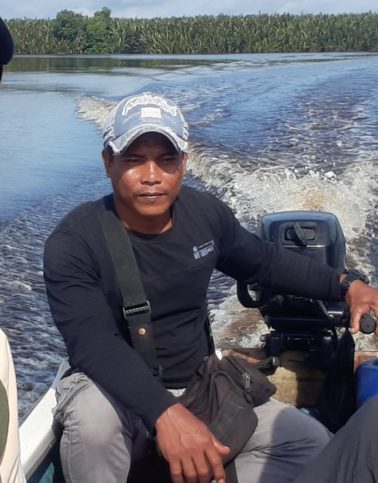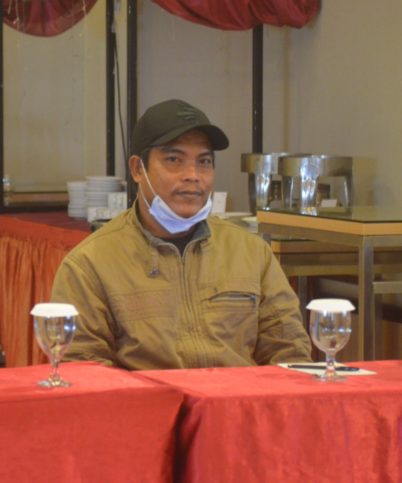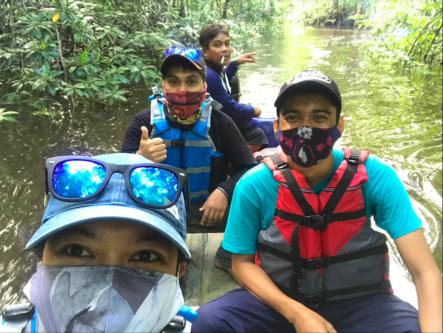Preserving potential non-timber products from mangrove forests to meet daily needs

Suheri on his boat to harvest wild honey in the mangrove forests of Batu Ampar | Photo: Yayasan Hutan Biru/ Blue Forests
Suheri, also known as Bang Heri, is a fisher from Batu Ampar Village in the Kubu Raya District of West Kalimantan, Indonesia. As well as fishing, Bang Heri is a wild honey hunter and the only forest honey farmer who is still active in his village. Suheri, of Bugis descent known for their good fishing skills, sees a huge potential in Batu Ampar Village because of its large forest area that covers 33,140ha. The village forest is also one of the largest in the whole Kubu Raya District with the majority of the trees being mangroves.
Mangrove forests are critical marine habitats that support high marine biodiversity and act as carbon sinks. However the forests have been threatened and are exploited globally for timber, firewood, medicinal purposes and, in some instances, are cleared for coastal development. Community actors like Suheri play an important role in showcasing the importance of conserving these forests, and living sustainably within them.
“Batu Ampar Village Forest has quite a lot of potential for Non-Timber Forest Products. Apart from wild honey in mangrove forest areas, there is also the potential for nypa, and others”. Nypa is a palm tree species whose products are derived from its sap including alcohol and unshaped sugar. “If properly handled, this village forest can provide many benefits for us,” said Bang Heri during an interview by our partner Lely Puspita from Yayasan Hutan Biru.
Bang Heri tells us he has harvested the honey for his own needs for years. Over time, he started to sell to neighbours and local markets and the popularity has grown among the community. The natural wild harvested honey is appreciated for it’s high quality and the health benefits it can offer. The popularity of the honey harvested from mangrove forest provides a good example showing how fishers can engage in alternative income generating activities tied to the natural environment. Advocating for fishers to take up alternative income generating activities can build the resilience of coastal communities, and provide motivation and support to conservation activities.
Sustainable forest honey harvesting
Bang Heri has always been enthusiastic about developing his knowledge of sustainable forest honey harvesting and has participated in a number of local training sessions. He understands how important it is to conserve mangrove bees and honey to use them in the long term. Focusing on improving his skills in wild honey farming, Suheri’s efforts have increased his earnings enough to reduce his dependency on fishing. “Every time I harvest forest honey, I don’t harvest all the beehives in the mangrove tree, but I leave a portion of the honeycomb so that the bees in it will begin to regenerate,” said Bang Heri, who has distributed samples of his forest honey to Makassar and Surabaya cities in Indonesia.
One of Bang Heri’s training on forest bees and honey production was through Organic Honey Education in Danau Sentarum facilitated by Sampan Kalimantan. Bang Heri was trained in harvesting organic honey, sustainable honey harvesting techniques, and ‘tikung’ harvesting techniques. The tikung harvesting technique is an Indigenous method of collecting honey bees sustainably. Sustainable honey harvesting technique is done by cutting off the head of the honeycomb and leaving the remaining honeycomb for brood regeneration. The process of extracting honey is not done by squeezing it but using a slicing system, where the honeycomb is sliced into small pieces so that the honey can come out by itself. It is believed that honey that is sliced can last up to 5 years, in contrast to honey that is only squeezed, which lasts for one year!

Suheri in a training of trainers held by Blue Forests in January 2021 | Photo: Yayasan Hutan Biru/ Blue Forests
Bang Heri also received training on the cultivation of Apis dorsata bees (wild / forest bees) using the tikung technique. Unlike the previous technique, the tikung technique is done by making pieces of board smeared with honey encouraging the bees to descend to a lower area which is easier to harvest. However, we can only implement this technique in terrestrial forests and not in mangrove forests because bees in mangrove areas are accustomed to high locations and only in certain trees. Also, when the position of the beehive in the mangrove area is placed too low, this can cause the taste of honey to be saltier.
Bang Heri is a member of the Village Forest Manager (LPHD), which oversees the Social Forestry Business Group (KUPS) and he hopes that the village forest will be well preserved. Because with protected village forests, we can produce more and better-quality wild honey. To increase the production of honey and other non-timber products from mangrove forests, the communities are proactively managing their forests including taking part in replanting initiatives. Aside from honey, by conserving mangrove forests, there is the potential for the local community to benefit from blue carbon income that could support healthcare and education initiatives. By promoting sustainable alternative income generation activities such as Suheri’s wild honey farming through all zones with mangrove forests, he hopes to highlight the importance of preserving mangroves to contribute to a sustainable future for people and nature alike.
Nisa was supported by Pesisir Lestari and Yayasan Hutan Biru during the interview with Bang Heri.






I like these projects conducted for the environment sustainability but how I may participate am very impressive and I would like to be part on acomplishinng that activity for future generations in Tanzania